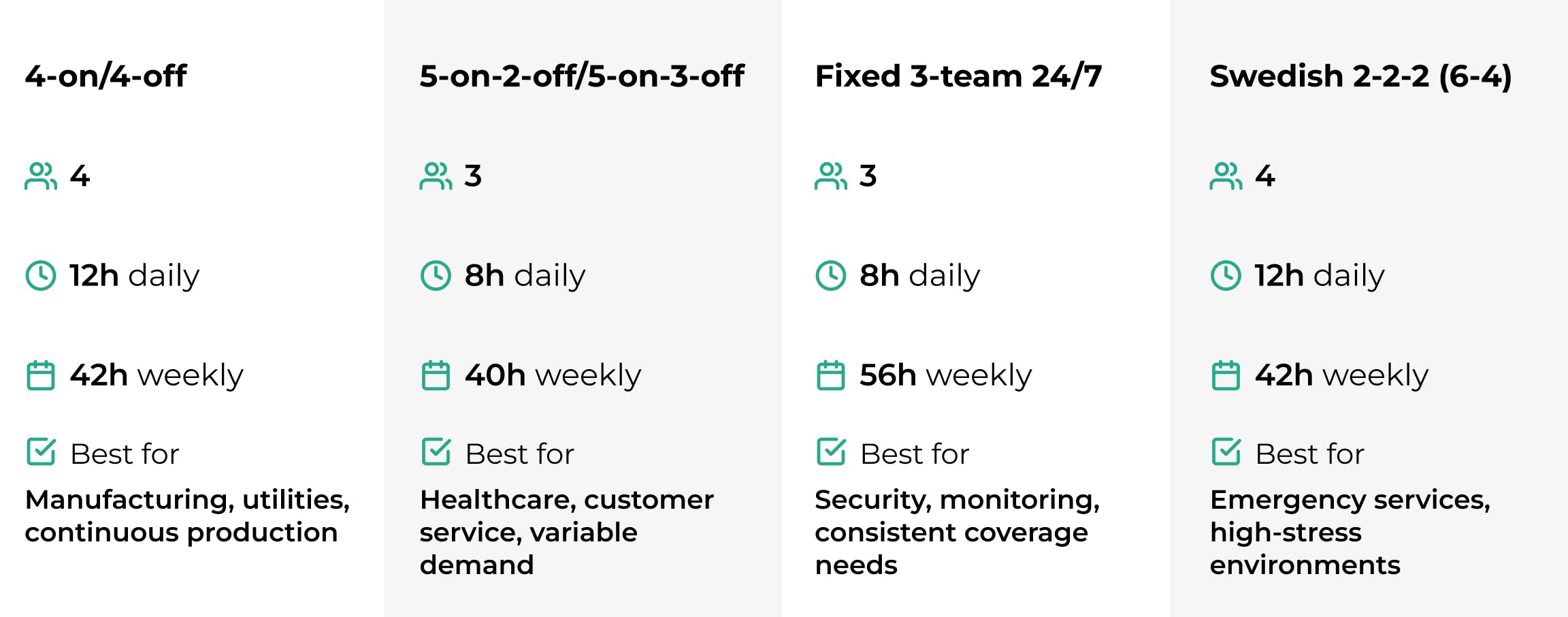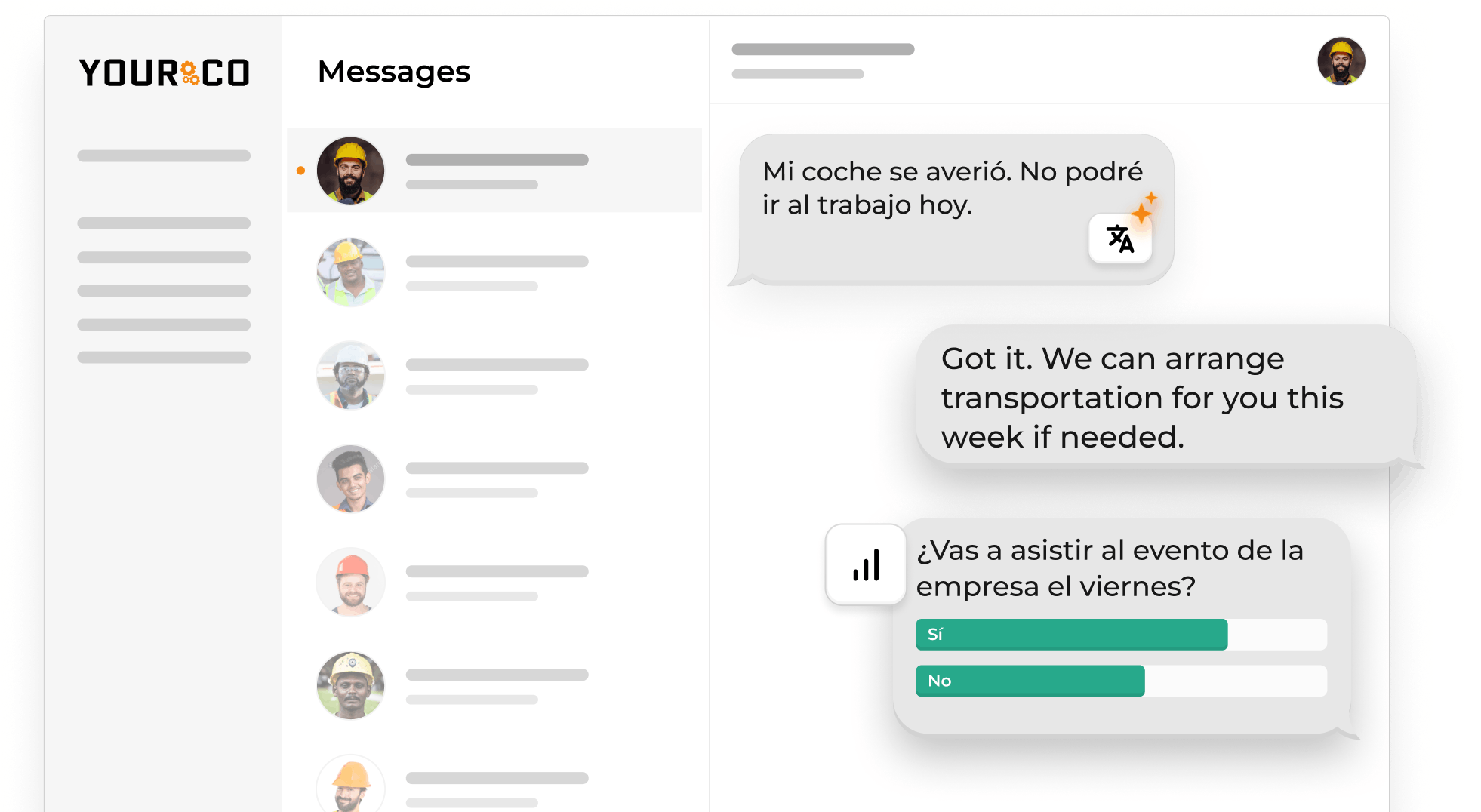How to Build a 24 Hour Coverage Shift Schedule That Actually Works


Managing a 24 hour coverage shift schedule for round-the-clock operations puts you in a constant balancing act: keeping coverage, controlling costs, staying compliant, and preventing burnout. Whether you run a hospital, factory, security team, or emergency service, a poor 24 hour coverage shift schedule creates problems that spread throughout your organization.
This guide gives you proven templates and a straightforward 5-step framework to deliver three outcomes: solid operational coverage, predictable schedules for your team, and built-in protections for staff well-being. No theory, just approaches you can use today. You'll learn how to balance operational needs with employee health while maintaining productivity and compliance. And best of all, you'll discover how effective communication tools can help make your scheduling transitions smoother.
The framework and calculators that follow will help you design, test, and implement a 24 hour coverage shift schedule that serves both your operational needs and your people. We have researched and tested these real solutions across industries where failure isn't an option.
Quick-Start: Proven 24 Hour Coverage Shift Patterns at a Glance
Skip the guesswork and start with schedules that already work. These four tested patterns form the backbone of successful 24 hour coverage shift schedules across industries. Each offers distinct advantages for different operational needs and workforce preferences.

4-on/4-off, 12-hour (4 teams) shift pattern involves employees working for four consecutive 12-hour shifts followed by four consecutive days off. This predictable alternating cycle ensures that workers enjoy significant rest between their work periods, promoting an excellent work-life balance. Employees are provided with long weekends, which leads to reduced burnout and higher job satisfaction. This schedule is particularly popular in industries such as manufacturing, where long shifts are common, and it helps reduce turnover rates by offering extended time off, which is highly valued by employees.
5-on-2-off/5-on-3-off, 8-hour (3 teams) schedule involves a three-team structure where employees work five 8-hour shifts, followed by two days off, and then five more shifts with three days off. This setup maintains continuous coverage without overburdening employees with excessive overtime. It is particularly suited for industries that require constant availability, such as healthcare. The two-day break after the first set of shifts ensures employees have enough rest, while the three-day break following the second set of shifts allows for extended recovery time. This balance helps prevent burnout and promotes better focus during working hours.
Fixed 3-team 24/7, 8-hour pattern is designed to ensure continuous coverage throughout the week with a fixed three-team structure. Employees work in shifts (morning, afternoon, or night), each lasting 8 hours. While this structure allows for 24/7 operations, it requires careful management to prevent fatigue due to the higher weekly hour commitment. The predictability of this schedule is advantageous for both employees and managers, as it allows workers to plan their personal lives around consistent work hours. However, it does require managers to remain vigilant in monitoring for burnout and ensuring workers have adequate time off.
Swedish 2-2-2 (6-4) pattern offers significant health benefits, with built-in long weekends that improve overall work-life balance. Employees work in a repeating cycle of two days on, two days off, two days on, and then have four days off. This schedule offers four consecutive days off every other week, which helps workers recover more effectively from work stress. This schedule is particularly well-suited for high-stress environments where employees need extended recovery time to prevent burnout. It is often used in settings that demand high performance, like healthcare, where the need for rest and recuperation is essential for maintaining employee well-being.
Manufacturing, healthcare, security, and energy sectors have proven these 24 hour coverage shift schedules work. The next sections show you exactly how to choose between them or customize these foundations for your specific needs. You'll build on established success rather than experimenting with untested approaches.
How to Build Your 24 Hour Coverage Shift Schedule in 5 Steps
Creating an effective 24 hour coverage shift schedule requires a structured approach that balances operational needs with employee well-being. This 5-step framework helps you consider all critical factors before implementation, preventing costly mistakes and employee dissatisfaction down the road.
Step 1 – Map Demand & Critical Roles
Start by analyzing your operational needs across different times and days. Identify peak demand periods and determine minimum staffing requirements for each role during various times. This mapping process maintains coverage and ensures continuous operations without overstaffing during slower periods.
Document your busiest hours, seasonal variations, and special events that affect staffing needs. Leverage tools for mobile workforce scheduling to efficiently manage and adapt to these patterns. Consider which positions need coverage at all times versus those that can operate with reduced staff during off-peak hours. This analysis drives all your subsequent scheduling decisions.
Step 2 – Select Shift Length
Your choice between 8-hour, 10-hour, or 12-hour shifts significantly affects workload sustainability and legal compliance. As shift durations increase, especially beyond 8 hours, employees report higher levels of mental and physical fatigue. Consider factors like job intensity, physical demands, compensation strategies, and concentration requirements when making this decision.
Eight-hour shifts offer better work-life balance and reduced fatigue, while 12-hour shifts provide more days off but may increase burnout risk. Factor in your industry's safety requirements and employee preferences when selecting shift length.
Step 3 – Pick Rotation Style & Team Count
Determine whether you'll use fixed patterns (employees work the same shift consistently) or rotating patterns (employees cycle through different shifts). Your team configuration—whether 3-team, 4-team, or 5-team systems—depends on your coverage needs and shift length selection from Step 2.
Consider how rotation styles affect employee circadian rhythms and plan accordingly.
Step 4 – Run Cost & Compliance Numbers
Model your costs carefully, including overtime requirements and compliance considerations. Calculate total labor costs, factor in absence coverage, evaluate your compensation strategies, and verify your schedule meets all labor law requirements. Health and safety compliance factors become especially critical in 24 hour coverage shift schedules where fatigue can increase accident risk.
Review maximum consecutive working days, required rest periods between shifts, and overtime thresholds. Document these requirements to avoid costly violations later.
Step 5 – Validate With Employees
Never skip this step. Employee involvement in shift scheduling drives higher productivity and reduced error rates. Gather feedback on proposed schedules before finalizing them, as employees often spot practical issues management might miss.
Use employee feedback, focus groups, or town halls to collect input. Address concerns proactively and explain the rationale behind scheduling decisions. This involvement creates buy-in and smoother implementation.
How to Choose the Right Shift Length
Shift length shapes everything from employee fatigue to your overtime budget. Choose wrong, and you'll face higher turnover, safety incidents, and blown labor costs. Choose right, and you'll build a sustainable operation that works for both your business and your people.
8-Hour Shifts Work Best for High-Risk Operations
8-hour shifts remain the gold standard because they align with natural energy cycles and keep fatigue manageable. Your team stays alert throughout their shifts, and the shorter duration makes work-life balance easier to maintain. The downside? You'll handle more handovers each day, creating more opportunities for miscommunication, and employees get fewer consecutive days off compared to longer shift patterns.
12-Hour Shifts Maximize Days Off But Increase Risk
12-hour patterns deliver compelling work-life benefits, giving employees more consecutive days off and reducing your scheduling complexity. But the trade-off is significant: longer shifts create dangerous fatigue, especially in physically demanding roles. Performance drops in those final hours, and accident risk climbs.
10-Hour Shifts Split the Difference
10-hour shifts offer a middle path—compressed workweeks with potential three-day weekends while avoiding the extreme fatigue of 12-hour shifts. They work well in emergency services and moderate-intensity manufacturing where you need extended coverage without pushing people to their limits.
The math tells a clear story: 8-hour shifts typically require 21 shifts per employee over three weeks, while 12-hour shifts need only 14 shifts in the same period. Research confirms that "as shift durations increase, especially beyond 8 hours, employees report higher levels of mental and physical fatigue."
Your operation's physical demands and safety requirements should drive this choice. High-concentration or safety-critical work demands 8-hour shifts. Operations where extended time off provides real value and work intensity stays manageable can handle 12-hour shifts. When you need compressed schedule benefits without extreme fatigue risks, 10-hour shifts offer the sweet spot.
How to Choose Between Fixed, Rotating, and Hybrid Patterns
Each shift pattern type serves different organizational goals and workforce preferences. Understanding the differences helps you select what works best for your situation.
Fixed Patterns keep employees on the same shift—always days, evenings, or nights. This creates stability for your team's sleep cycles and personal lives. They can maintain consistent sleep schedules and plan around predictable work hours. The drawbacks? Some people get stuck with less desirable shifts, and permanent night workers face long-term fatigue issues. A common example is the 3-team fixed 8-hour pattern with permanent assignment to days (7am-3pm), evenings (3pm-11pm), or nights (11pm-7am).
Rotating Patterns move employees through different shifts over time. This approach spreads the burden of night shifts and gives everyone varied experience. Nobody gets permanently stuck on the graveyard shift. The challenge? Your team constantly adjusts their sleep schedules, disrupting their body clocks. Popular examples include the 4×12 rotation and 2-2-3 (Pitman) schedule, where employees work two days on, two days off, three days on, then alternate the following week. The Swedish 2-2-2 (6-4) pattern offers excellent work-life balance with built-in long weekends.
Hybrid Patterns mix fixed and rotating elements or create specialized arrangements for specific needs. These might include weekend-only crews alongside regular rotating staff, or different shift lengths for different days. This flexibility helps match staffing to actual demand patterns.
When choosing your pattern, consider what your operation needs (steady coverage vs. variable staffing), what your workforce prefers, and health impacts. Rotating shift workers, especially those moving between day and night, face increased risk of sleep disorders and chronic health problems. Your goal is to balance operational efficiency with your team's long-term health.
How to Calculate Staffing, Costs & Compliance
Proper staffing calculations separate successful 24 hour coverage shift schedules from costly disasters. You need enough people to maintain coverage without breaking budgets or violating labor laws. These formulas and checklists help prevent expensive mistakes before they happen.
Start With the Basic Formula
Here's how the math works using a fixed 3-team 8-hour pattern:
168 coverage hours ÷ 40 = 4.2 FTE (Full-Time Equivalent) per position
Breaking this down:
- 168 = total hours in a week (24 hours × 7 days)
- 40 = standard full-time hours per employee per week
- 4.2 = Full-Time Equivalents needed before accounting for time off
You need 4.2 people working full-time to cover one position around the clock. But real operations require more. Always round up.
The Complete Staffing Formula
This formula accounts for actual workplace conditions:
Employees needed = (total coverage hours per week ÷ average hours per employee per week) × absence factor
The absence factor accounts for vacation time, sick leave, training days, and other absences. Use these multipliers:
- 1.1 for low-absence environments with minimal time off
- 1.2 for typical operations with standard vacation and sick time
- 1.3 for high-absence environments or roles requiring extensive training
For our 3-team example: 4.2 × 1.2 = 5.04 employees needed per position to maintain reliable coverage.
Legal Compliance Checkpoints
Run through these requirements before finalizing your schedule:
- Maximum consecutive days worked - Most jurisdictions limit continuous work periods
- Required rest periods between shifts - Verify adequate recovery time between shift changes
- Overtime thresholds and calculations - Track when overtime kicks in (typically after 8 hours daily or 40 hours weekly)
- Night work regulations - Some regions have additional requirements for overnight shifts
- Documentation for extended shifts - Keep records justifying longer shifts when necessary
- Industry-specific rules - Healthcare, transportation, and other sectors often have unique requirements
Avoid Expensive Mistakes
Understaffing creates employee burnout, safety incidents, and service failures that damage your reputation. Overstaffing wastes money on unnecessary labor costs and reduces profitability. These calculations serve as your defense against both scenarios.
Monitor your actual results and adjust the formulas based on your organization's specific patterns of attendance, productivity, and operational demands. The math provides your starting point, but real-world data drives ongoing optimization.
How to Protect Your Team From Shift Work Health Risks
Shift work brings real health risks and workplace hazards that affect both your team and your bottom line. This matters not just for employee wellbeing but directly impacts your productivity and compliance. Smart fatigue prevention keeps your operation running smoothly while keeping your people healthy.
Design Forward Rotations With Real Recovery Time
Build your rotations to move forward through the day, from morning to afternoon to night, rather than backward. This approach works with your employees' natural sleep cycles instead of fighting them. Workers rotating between day and night shifts face higher risks of sleep disorders and chronic health issues, so the direction matters more than you might think. The Swedish 2-2-2 pattern shows how this works in practice, giving workers four straight days off to completely reset their sleep patterns.
Keep Night Shifts Short and Sweet
Never schedule more than 2-4 consecutive night shifts. The research confirms this approach, as longer shifts, especially beyond 8 hours, leave employees mentally and physically drained. One experienced shift worker put it perfectly: "Most people can sustain well for 6 to 8 hours, but those last 4 hours in the shift, they tax you."
Give Your Team the Right Tools to Stay Healthy
Support your employees with practical resources they can actually use: sleep hygiene training, nutrition guidance for shift workers, heat safety tips, and fatigue management education. These resources directly combat the increased fatigue, decreased alertness, and cognitive problems that occur when circadian rhythms get disrupted.
Employee Wellness Checklist:
- Keep consistent sleep schedules, even on days off
- Create the right sleep environment: dark, quiet, and cool
- Time caffeine strategically and avoid it 6 hours before sleep
- Manage light exposure: bright during work, dark before sleep
- Exercise regularly, but not close to bedtime
- Eat lighter meals during night shifts
How to Monitor and Optimize Your 24 Hour Coverage Shift Schedule After Launch
Your new 24 hour coverage shift schedule is live, but the real work starts now. A structured 30-/60-/90-day review cycle captures what's working and quickly addresses what isn't. This systematic approach gives you the data needed for informed adjustments without disrupting operations. Most scheduling failures happen because managers think "set it and forget it" works—it doesn't.
Start your 30-day review by focusing on immediate operational impacts. Are all shifts filled without excessive overtime? Check handoff quality between shifts and gather initial employee feedback about the transition. Look for quick wins like adjusting break timing or clarifying handover procedures that can be implemented right away.
The 60-day mark is when you expand analysis to key performance indicators. Employee involvement in scheduling directly impacts satisfaction and productivity, so measure absenteeism rates, overtime hours, and patterns in employee feedback. Pay attention to supervisor observations about team dynamics and energy levels across different shifts. Addressing any issues and improving team communication during this phase is critical to ensure ongoing success. You'll start seeing whether the schedule truly supports your operational goals.
Your 90-day review provides the comprehensive assessment. Compare pre- and post-implementation data across all metrics: productivity levels, quality scores, service delivery, employee satisfaction, and total labor costs. This becomes your decision point for continuing, modifying, or potentially replacing the schedule.
Track these specific metrics consistently:
- Operational: productivity rates, quality scores, customer service levels
- Workforce: absenteeism, tardiness, turnover, overtime hours
- Safety: incident reports, near-misses, error rates
- Wellbeing: satisfaction surveys, work-life balance feedback, health indicators
Use Yourco's analytics capabilities to systematically gather employee feedback through polls and surveys at each review stage. The platform collects input from all shifts, ensuring you hear from every part of your workforce, not just day-shift employees.
Document both successes and challenges throughout this process. Return to your original staffing calculations and cost models to validate whether real-world results match your projections. Adjust your approach based on these insights—your schedule should evolve with your operation.
How to Customize 24 Hour Coverage Shift Schedules When Standard Patterns Don't Fit
Standard shift patterns won't always match your unique operational needs. Your peak hours might be concentrated in specific windows, or your workforce might have preferences that traditional schedules can't accommodate. Custom hybrid approaches solve these mismatches by combining the best elements of different scheduling strategies. These tailored solutions deliver the coverage you need while keeping employees satisfied.
Day-Shift Heavy Operations excel when your business has concentrated peak hours. A 5 am–3:30 pm, four-day schedule extends coverage during prime business hours while giving employees compressed workweeks. Distribution centers and retail stores benefit most from this approach since their activity peaks during daylight hours. You get extended coverage without the complexity of full 24/7 staffing, and employees appreciate the three-day weekends.
Contractor-Led Weekend Crews blend predictability with flexibility. Your core team works three standard eight-hour shifts Monday through Friday, while contract workers handle weekend coverage. This keeps permanent employees happy with predictable weekday schedules while letting you scale weekend staffing based on demand. Core employee retention improves, and operational continuity stays intact. The challenge lies in managing knowledge transfer between permanent and contract staff.
Alternative Rotation Patterns like 6-on-3-off and 5-on-3-off schedules work well for specific workforce demographics. These patterns provide longer recovery periods between work blocks, appealing to employees who prefer concentrated work followed by extended time off. The extended rest periods can reduce burnout and improve job satisfaction.
Custom scheduling approaches let you adjust team sizes, shift lengths, and rotation patterns to match your specific needs. You can optimize for both coverage and employee satisfaction, though implementation becomes more complex and may require sophisticated scheduling tools.
These approaches prove valuable for seasonal operations, growing businesses, or companies with distinct weekend versus weekday patterns. Run thorough cost modeling before implementing any hybrid approach to ensure the added complexity delivers measurable benefits that justify the investment.
Troubleshooting Common Pain Points
When you're managing a 24 hour coverage shift schedule, scheduling challenges are inevitable. Here's your quick-reference guide to identifying and solving the most common issues that can disrupt your operations and frustrate your workforce.
Coverage Gaps
The root causes often stem from understaffing during peak periods, predictable absence patterns you haven't accounted for, or poor handover processes between shifts. To address these gaps, implement overlap shifts during transition periods to ensure continuity, establish a structured on-call rotation system, and cross-train employees across different roles and shifts. Remember to revisit your staffing calculations regularly—what worked for 8-hour shifts may need adjustment for 12-hour patterns.
Excess Overtime
Unrealistic scheduling expectations and inadequate baseline staffing typically drive overtime costs through the roof. Start by analyzing your overtime patterns to identify recurring problem areas, then adjust your base staffing levels accordingly. Set up automated alerts when overtime approaches predetermined thresholds. When coverage gaps do occur, Yourco's SMS solution can quickly reach available staff members, helping you find voluntary coverage before resorting to mandatory overtime.
Burnout Complaints
Combat burnout by limiting consecutive long shifts, ensuring adequate rest periods between shift blocks, and rotating undesirable shifts fairly among all staff. Use Yourco's survey capabilities to regularly monitor employee wellbeing and catch burnout symptoms early, before they lead to turnover or performance issues.
Swap Chaos
Uncontrolled shift swapping creates confusion and potential coverage problems. Addressing scheduling conflicts is essential to maintain smooth operations. Establish clear policies defining who can swap with whom, requiring advance notice for swaps, and mandating managerial approval for all changes. Yourco's two-way messaging features can streamline this process by creating organized swap request channels and maintaining automatic records of all approved changes.
Last-Minute Call-Outs
Develop contingency plans that include maintaining a list of employees willing to work extra shifts, creating incentive programs for reliable attendance, and establishing protocols for different types of absences. When call-outs happen, Yourco's SMS capabilities can simultaneously reach multiple potential replacements, dramatically reducing the time needed to secure coverage.
Legal Non-Compliance
Shift work compliance issues often arise from inadequate rest periods, excessive consecutive work hours, or improper overtime calculations. Conduct weekly schedule audits against relevant labor regulations, maintain detailed documentation of all scheduling decisions and exceptions, and integrate compliance checking into your scheduling software. Schedule instability itself can impact worker wellbeing, so maintain consistent patterns whenever possible.
Cross-Industry Adaptability
The core principles of effective scheduling translate across industries, but the specific implementation varies significantly. Healthcare facilities need to account for patient acuity levels, manufacturing operations must consider production cycles, and security services require coverage that accounts for threat levels and special events. Adapt your scheduling approach by understanding your industry's unique peak demand patterns, regulatory requirements, and skill-mix needs, while maintaining the fundamental principles of fairness, adequate rest, and clear communication.
The key to resolving these pain points lies in proactive planning, clear communication, and leveraging technology to streamline processes. If turnover remains high, consider gathering data through exit survey questions to identify underlying issues. Most scheduling problems are predictable and preventable with the right systems and approach.
Take Your 24 Hour Coverage Shift Schedule to the Next Level

Building an effective 24-hour coverage shift schedule isn’t just about filling slots; it’s about ensuring smooth operations while safeguarding the well-being of your workforce. The key to success lies in balancing peak demand with employee needs, creating a predictable work environment that avoids burnout and keeps morale high. But even the best-designed shift schedules can falter without clear and consistent communication.
Yourco’s SMS-based platform ensures that all your non-desk employees stay informed and confident about schedule changes, without relying on emails or apps that may be ignored or inaccessible. With SMS, you’re tapping into a communication channel that employees already know and trust. No internet, no app downloads, no passwords needed. Whether it’s sending shift reminders, personalized schedule information, collecting real-time feedback through simple in-built polls, or confirming receipt of critical updates, Yourco equips you with the tools you need to keep your operations running smoothly.
By integrating these communication capabilities into your scheduling processes, you can significantly reduce confusion, minimize errors, and boost employee engagement. The process doesn’t stop once the schedule is implemented. Employee feedback and performance metrics help you continuously fine-tune your approach, ensuring that your scheduling model evolves alongside your business needs. With Yourco, you don’t just optimize shift patterns for coverage, you build a responsive, sustainable system that nurtures both productivity and employee satisfaction.
Ultimately, the right shift schedule, backed by effective communication, is your secret weapon for building a 24/7 operation that works for everyone. With Yourco, you get the structure, tools, and insights needed to make this happen.
Try Yourco for free today or schedule a demo and see the difference the right workplace communication solution can make in your company.
Quick Insights on Managing 24-Hour Shift Schedules
1. What are the shifts for 24-hour coverage?
To cover 24 hours, you can use several shift patterns depending on your operational needs. One common option is three 8-hour shifts: morning (7 AM - 3 PM), afternoon (3 PM - 11 PM), and night (11 PM - 7 AM). This rotation ensures that the workforce remains available throughout the day. Alternatively, some operations prefer two 12-hour shifts, with day shifts from 7 AM to 7 PM and night shifts from 7 PM to 7 AM. Another option is the 4-on/4-off, 12-hour pattern, where employees work four consecutive 12-hour shifts followed by four days off. This schedule is often used in industries like manufacturing or utilities, where continuous production is needed. The choice between these patterns depends on the type of work being done and the preferences of the workforce.
2. How do I build a 24-hour shift schedule?
To create a 24-hour shift schedule, start by analyzing your operational demand and staffing needs. Identify when your business experiences peak demand and determine how many staff members are required during these times. Then, select an appropriate shift length, such as 8, 10, or 12 hours, based on the nature of the work. For high-intensity roles, shorter shifts (8 hours) may be better to prevent fatigue, while longer shifts (12 hours) may work better for industries that benefit from more extended time off. Next, choose whether to use fixed or rotating shifts. Fixed shifts provide consistency for employees but can lead to burnout for those on night shifts, while rotating shifts ensure no one is permanently stuck on the night shift. Finally, factor in the cost of labor, legal compliance for working hours, and gather feedback from employees to ensure the schedule works for everyone.
3. What is the 24/7 shift pattern formula?
To determine staffing needs for a 24/7 coverage schedule, divide 168 hours (the total number of hours in a week) by the standard 40-hour workweek. This gives you 4.2 full-time employees (FTEs) required to cover one position. However, if your workplace experiences absenteeism or requires more flexibility, adjust this number by applying an absence factor (typically between 1.2 and 1.3, depending on your operational environment). For example, using a 1.2 factor, you would need 5.04 FTEs to cover one position.



